tow PONTIAC PONTIAC 1996 Owner's Manual
[x] Cancel search | Manufacturer: PONTIAC, Model Year: 1996, Model line: PONTIAC, Model: PONTIAC PONTIAC 1996Pages: 370, PDF Size: 17.69 MB
Page 187 of 370
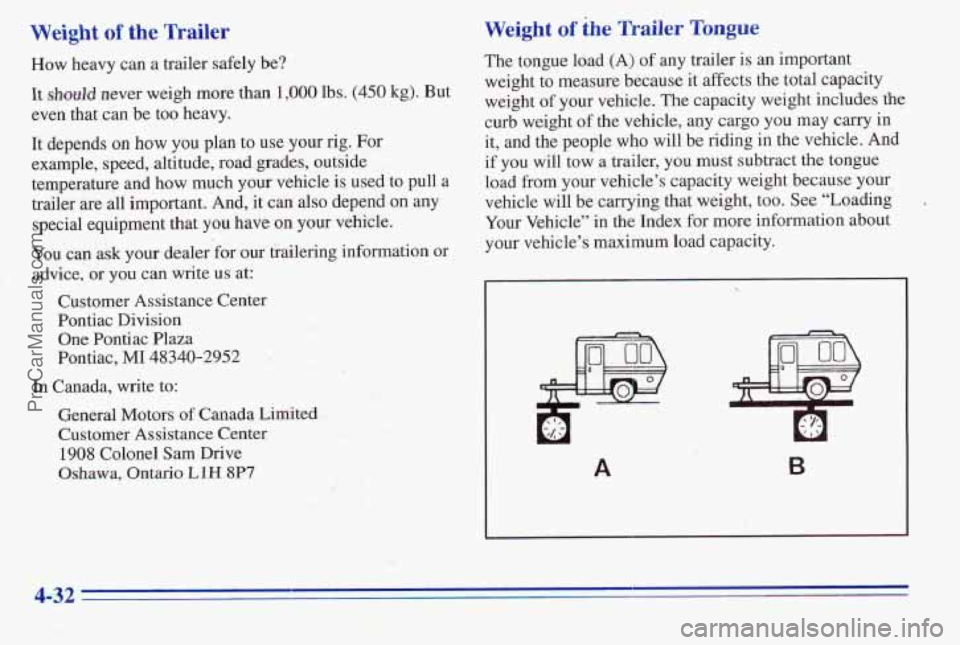
Weight of the Trailer
How heavy can a trailer safely be?
It should never weigh more than 1,000 lbs. (450’ kg). But
even that can be too heavy.
It depends
on how you plan to use your rig. For
example, speed, altitude, road grades, outside
temperature and how much
your vehicle is used to pull a
trailer are all important. And, it can also depend
on any
special equipment that you have on your vehicle.
You can ask your dealer ’for our trailering information or
advice,
or you can write us at:
Customer Assistance Center
Pontiac Division
One Pontiac Plaza
Pontiac,
MI 48340-2952
In Canada, write to:
General Motors
of Canada Limited
Customer Assistance Center 1908 Colonel Sam Drive
Oshawa, Ontario LlH 8P7
Weight of the Trailer Tongue
The tongue load (A) of any trailer is an important
weight to .measure bec.ause it affects the total capacity
weight
of your vehicle. The capacity weight includes the
curb weight of the vehicle, any cargo you may carry in
it, and the people
who will be riding in the vehicle. And
.if you will tow a trailer, you must subtract
the tongue
load
from your vehicle’s capacity weight because your
vehicle will be carrying that weight, too. See “Loading
Your Vehicle” in the Index for more information about
your vehcle’s maximum load capacity.
A B
4-32 -
ProCarManuals.com
Page 189 of 370
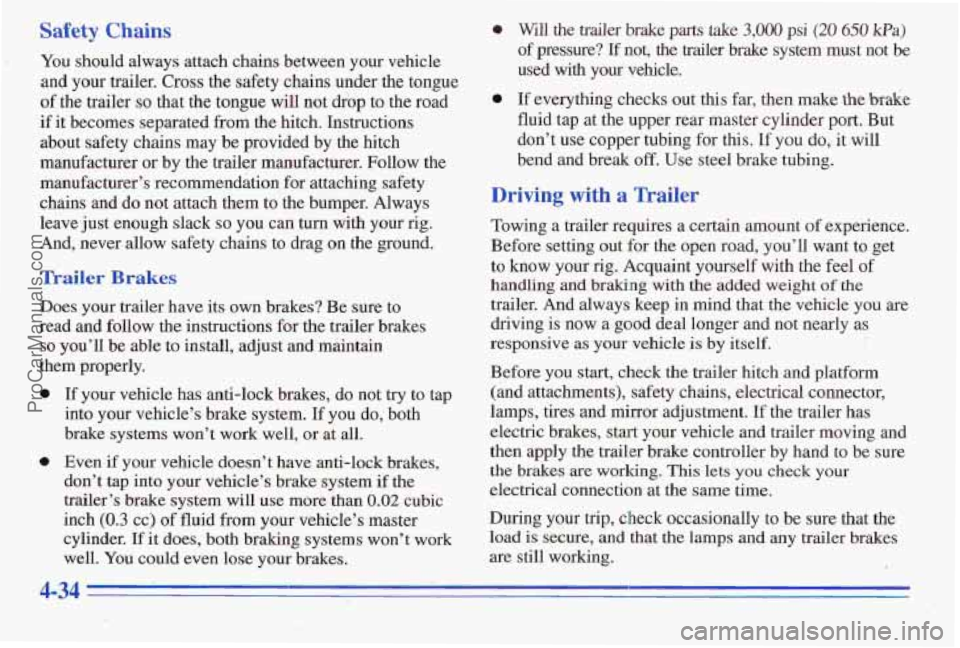
Safety Chains
You should always attach chains between your vehicle
and your
trailer. Cross the safety chains under the tongue
of the trailer so that the tongue will not drop to the road
if it becomes separated from the hitch. Instructions
about safety chains may be provided by the hitch
manufacturer
or by the trailer manufacturer. Follow the
manufacturer’s recommendition for attaching safety
chains and do not attach them to the bumper. Always
leave just enough slack’s0 you can
turn with your rig.
And, never allow safety chains to drag on the ground.
Trailer Brakes
Does your trailer have its own brakes? Be me to
read and follow the instructions for the trailer brakes
so you’ll be able to install, adjust and maintain
them properly.
0
0 If your vehicle has anti-lock brakes, do not try to tap
into your vehicle’s brake system.
If you do, both
brake systems won’t work well,
or at all.
Even if your vehicle doesn’t have anti-lock brakes,
don’t tap into
your vehicle’s brake system if the
trailer’s brake system will use more than
0.02 cubic
inch
(0.3 cc) of fluid from your vehicle’s master
cylinder.
If it does, both braking systems won’t work
well.
You could even lose your brakes.
0 Will the trailer brake parts take 3,000 psi (20 650 Pa)
of pressure?
If not, the trailer brake system must not be
used with
your vehicle.
0 If everything checks out this far, then make the brake
fluid tap at the upper rear master cylinder port. But
don’t use copper tubing for this.
If you do, it will
bend and break
off. Use steel brake tubing.
Driving with a Trailer
Towing a trailer requires a certain amount of experience.
Before setting out for the open road, you’ll want to get
to know your rig. Acquaint yourself with the feel of
handling and braking with the added weight of the
trailer. And always keep
in mind that the vehicle you are
driving is ~lolw
a good deal longer and not nearly as
responsive
as your vehicle is by itself.
Before you start, check the trailer hitch
and platform
(and attachments), safety chains, electrical connector,
lamps,
tires and mirror adjustment. I% the trailer has
electric brakes, start your vehicle and trailer moving and
then apply the traiEer brake controller by hand to be sure
the brakes are working.
This lets you check your
electrical connection at the Same time.
During your
hip, check occasionally to be sure that the
load
is secure, and that the lamps and any trailer brakes
are still working.
ProCarManuals.com
Page 190 of 370

Following Distance
Stay at least twice as far behind the vehicle ahead as you
would when driving your vehicle without
a trailer. This
can help you avoid situations that require heavy braking
and sudden turns.
Passing
You'll need more passing distance up ahead when
you're towing a trailer. And, because you're a good deal
longer, you'll need to go much farther beyond the
passed vehicle before you can return .to your lane.
Backing Up L
- i -. ,. .. ,.
-'l, '' I. . '.:', .i Hold the bottom of the steering wheel with one hand.
' ' Then, to move the trailer to the left, just move that hand
to the left. To move the trailer to the right, move your
hand to the right. Always 'back up slowly and,
if
possible, have someone guide you.
Making 'hms
I
I NOTICE:
Making very sharp turns while trailering'could
cause the trailer to come
in contact with the
vehicle. Your vehicle could be damaged. Avoid
making very sharp turns while trailering.
When you're turning with a trailer, make wider
. . turns than normal. Do this so your trailer won't
strike soft shoulders, curbs, road signs, trees or other
objects. Avoid jerky or sudden maneuvers. Signal well
in advance.
ProCarManuals.com
Page 191 of 370
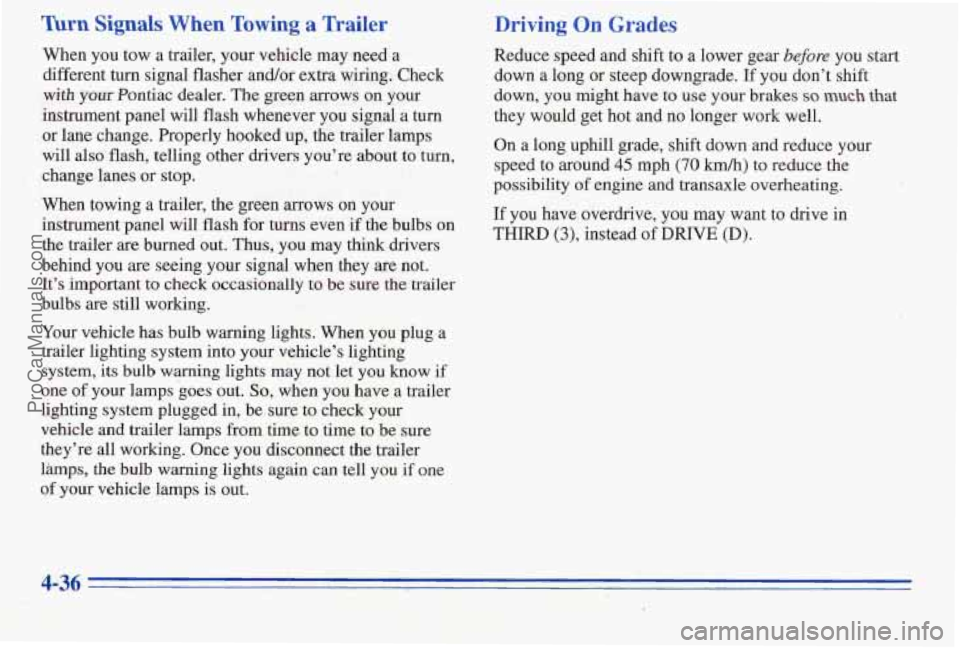
Turn Signals When Towing a Wailer
When you tow a trailer, your vehicle may need a
different turn signal flasher and/or extra wiring. Check
with your Pontiac dealer. The green arrows on your
instrument panel will
flash whenever you signal a turn
or lane change. Properly hooked up, the trailer lamps
will also flash, telling other drivers you’re about to
turn,
change lanes or stop.
When towing a trailer, the green arrows on your
instrument panel will, flash for turns even if the bulbs
on
the trailer are burned out. Thus, you may think drivers
behind you are seeing your signal when they are not.
It’s important to check occasionally
to be sure the trailer
bulbs are still working.
Your vehicle has bulb warning lights. When you plug a
trailer lighting system into your vehicle’s lighting
system, its bulb warning lights may not let you
know if
one
of your lamps goes out. So, when you have a trailer
lighting system plugged
in, be sure to check your
vehicle and trailer lamps from time to time to be
sure
they’re all working. Once you disconnect the trailer
lhmps,
the bulb warning lights again can tell you if one
of your vehicle lamps is out.
Driving On Grades
Reduce speed and shift to a lower gear before you start
down a long or steep downgrade. If you don’t shift
down, you might have to use your
brakes so much that
they wouJd get hot and no longer work well.
On a long uphill grade, shift down and reduce your
speed to around
45 mph (70 km/h) to reduce the
possibility
of engine and transaxle overheating.
If you have overdrive, you may want to drive in
THIRD (3), instead of DRIVE (D).
4-36
ProCarManuals.com
Page 192 of 370
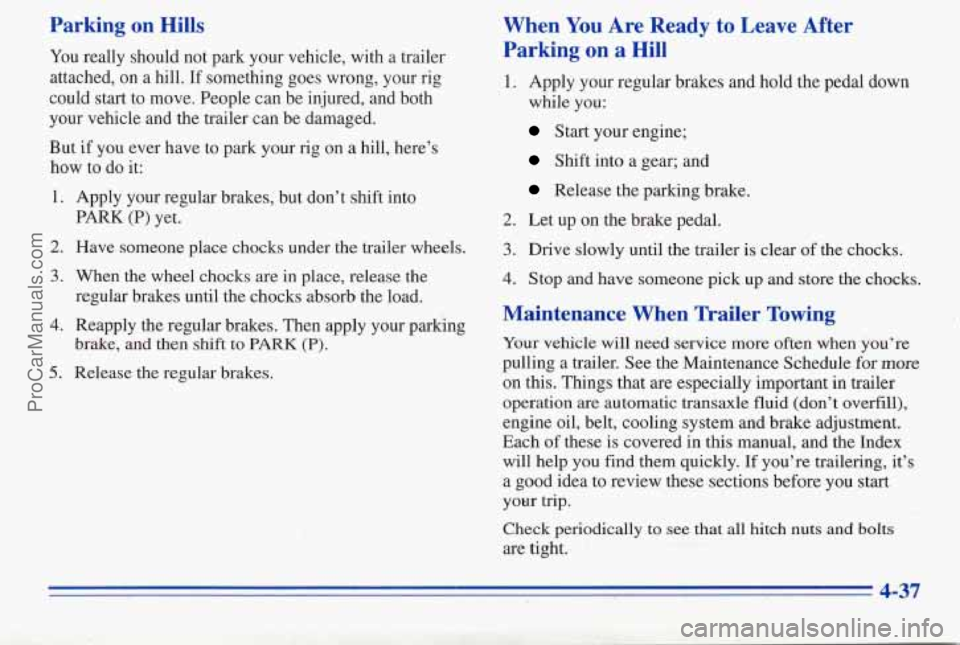
Parking on Hills
You really should not park your vehicle, with a trailer
attached, on
a hill. If something goes wrong, your rig
could
start to move. People can be injured, and both
your vehicle and the trailer can be damaged.
But if you ever have to park your rig on a hill, here’s
how to do it:
1.
2.
3.
4.
5.
Apply your regular brakes, but don’t shift into
PARK (P) yet.
Have someone place chocks under
the trailer wheels.
When the wheel chocks are in place, release the
regular brakes until the chocks absorb the load.
Reapply the regular brakes. Then apply your parking
brake,
and then shift to PARK (P).
Release the regular brakes.
When You Are Ready to Leave After
Parking on a Hill
1. Apply your regular brakes and hold the pedal down
while you:
Start your engine;
Shift into a gear; and
Release the parking brake.
2. Let up on the brake pedal.
3. Drive slowly until the trailer is clear of the chocks.
4. Stop and have someone pick up and store the chocks.
Maintenance When Trailer Towing
Your vehicle will need service more oken when you’re
pulling a trailer. See the Maintenance Schedule for -more
on this. Things that are especially important in trailer
operation
are automatic transaxle fluid (don’t overfill),
engine oil, belt, cooling system and brake adjustment.
Each
of these is covered in this manual, and the Index
will help you find them quickly. If you’re trailering, it’s
a good idea to review these sections before you start
your trip.
Check periodically to see that all hitch nuts and bolts
are tight. ’
4-37
ProCarManuals.com
Page 200 of 370

Towing Your Vehicle
Try to have a Pontiac dealer or a professional towing
service tow your Grand
Prix. See “Roadside Assistance”
in the- Index.
If your vehicle has been changed or modified since it
was factory-new by adding aftermarket items like
fog
lamps, aero skirting, or special tires and wheels, these
instructions and illustrations may not be correct.
Before you do anything, turn on the hazard
warning flashers.
When you call, tell the towing service:
That your vehicle cannot be towed from the front
That your vehicle has front-wheel drive.
The make, model and year of your vehicle.
Whether you can still move the shift lever.
0 If there was an accident, what was damaged.
When the towing service arrives, let the tow operator
know that this manual contains detailed towing,
instructions and illustrations. The operator may want to
see t.
with sling type equipment.
I I
I
To help avoid injury to you or others:
Never let passengers ride in a vehicle that is
Never tow faster than safe or posted speeds.
Never tow with damaged parts not
fully secured.
Never get under your vehicle after it has
been lifted by the tow truck.
Always secure the vehicle on each side with
separate safety chains when towing
it.
Never use J-hooks. Use T-hooks instead.
being towed.
‘I
ProCarManuals.com
Page 201 of 370

/r\, CAUTION:
A vehicle can fall from a car carrier if it isn’t
adequately secured. This can cause
a collision,
serio’us personal injury and vehicle damage. The
vehicle should be tightly secured with chains or
steel cables before it
is trapported.
Don’t
use substitutes (ropes, leather straps,
canvas webbing, etc.)
that can be cut by sharp
edges underneath the towed vehicle. Always use
T-hooks inserted in the T-hook slots. Never use
J-hooks. They will damage drivetrain and
suspension components.
~~
When your vehicle is being towed, have the ignition
turned
to the OFF position. The steering wheel should
be clamped in a straight-ahead position, with a
clamping device designed
for towing service. Do not
use the vehicle’s steering column lock for ths The
transaxle should be
in NEUTRAL (N) and the
parking brake released.
Don’t have your vehicle towed on the drive wheels,
unless you must. If the vehicle must be towed on the
drive wheels, be
sure to follow the speed and distance
restrictions later in this section or
your transaxle will be
damaged.
If these limitations must be exceeded, then the
drive wheels have to be supported on a dolly.
ProCarManuals.com
Page 202 of 370
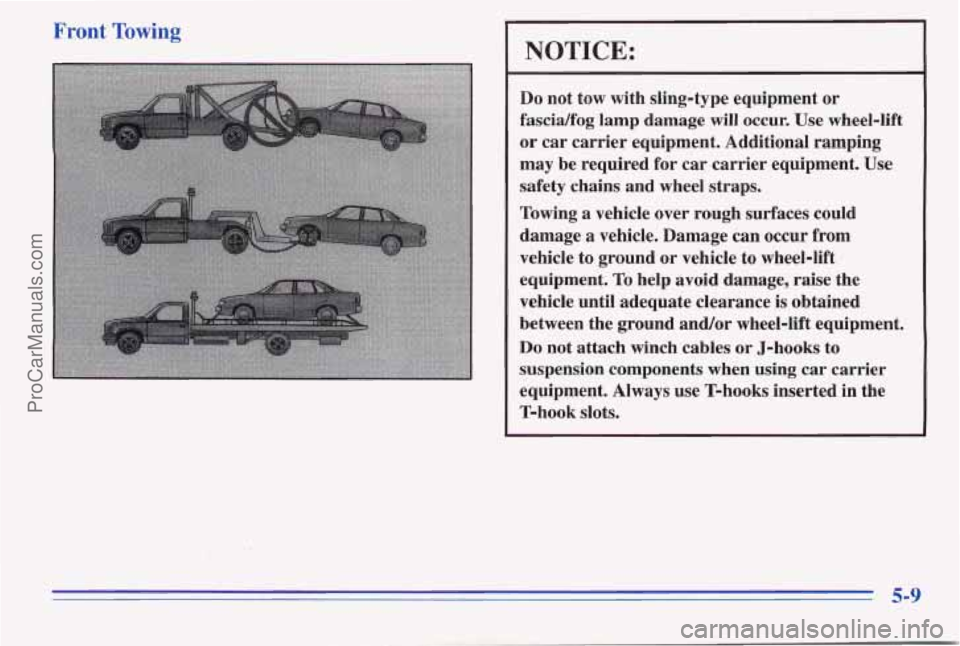
Front Towing
NOTICE:
Do not tow with sling-type equipment or
fascidfog lamp damage
will occur. Use wheel-lift
or car carrier equipment. Additional ramping
may be required for car carrier equipment.
Use
safety chains and wheel straps.
Towing a vehicle over rough surfaces could
damage
a vehicle. Damage can occur from
vehicle to ground or vehicle to wheel-lift
equipment.
To help avoid damage, raise the
vehicle until adequate clearance
is obtained
between the ground and/or wheel-lift equipment.
Do not attach winch cables or J-hooks to
suspension components when using car carrier
equipment. Always use
T-hooks inserted in the
T-hook slots.
5-9
ProCarManuals.com
Page 204 of 370
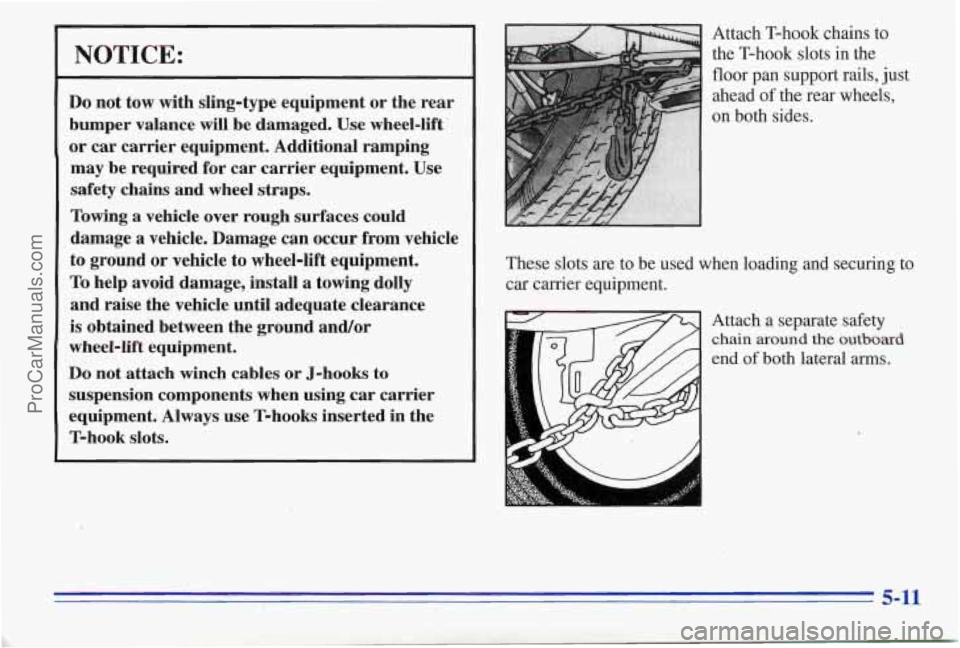
NOTICE:
Do not tow with sling-type equipment or the rear
bumper valance
will be damaged. Use wheel-lift '
or car carrier equipment. Additional ramping
may be required for car carrier equipment. Use
safety chains and wheel straps.
Towing a vehicle over rough surfaces could
damage a vehicle. Damage can occur from vehicle
to ground or vehicle to wheel-lift equipment.
To help avoid damage, install a towing dolly
and raise the vehicle until adequate clearance
is obtained between the ground and/or
wheel-lift equipment.
Do not attach winch cables or J-hooks to
suspension components when using car carrier
equipment. Always use T-hooks inserted in the
T-hook slots.
Attach T-hook chains to
the T-hook slots
in the
floor pan support rails, just
ahead of the rear wheels,
on both sides.
These slots are to be used when loading and securing to
car carrier equipment.
Attach a separate safety
chain around the outboard
end of both lateral arms.
5-11
ProCarManuals.com
Page 206 of 370
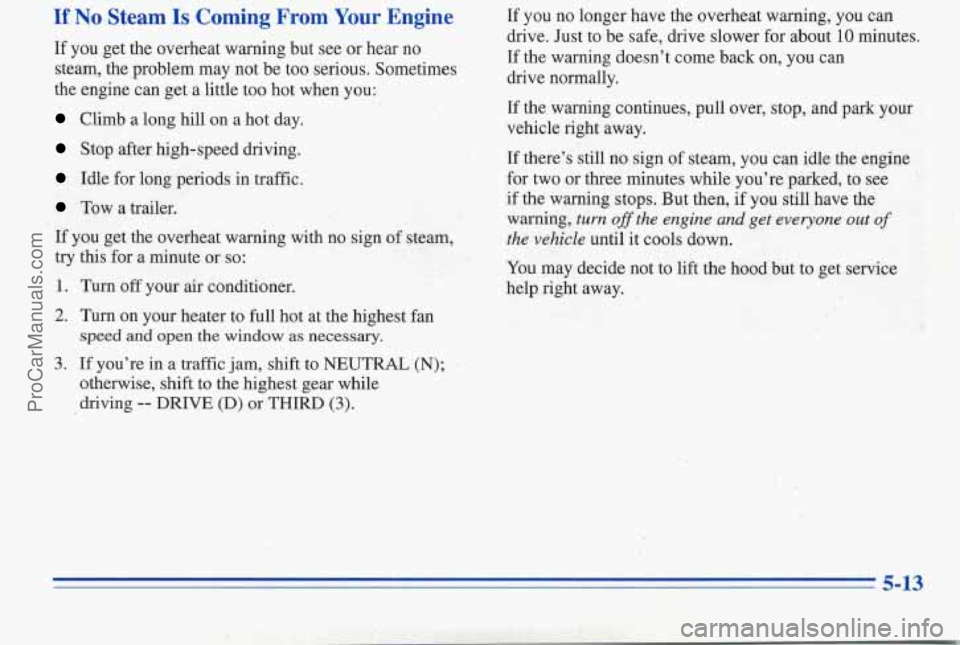
If No Steam Is Coming From Your Engine
If you get the overheat warning but see or hear no
steam, the problem may not be too serious. Sometimes
the engine can get a little too hot when you:
Climb a long hill on a hot day.
Stop after high-speed driving.
Idle for long periods in traffic.
Tow a trailer.
If you get the overheat warning with no sign of steam,
try this for a minute or
so:
1. Turn off your air conditioner.
2. Turn on your heater to full hot at the highest fan
3. If you’re in a traffic jam, shift to NEUTRAL (N);
speed and open the window as necessary.
otherwise, shift to the highest gear while
driving
-- DRIVE (D) or THIRD (3).
If you no longer have the overheat warning, you can
drive. Just to be safe, drive slower for about
10 minutes.
If the warning doesn’t come back on, you can
drive normally.
If the warning continues, pull over, stop, and park your
vehicle right away.
If there’s still no sign of stem, you can idle the engine
for two or three minutes while you’re parked, to see
if
the warning stops. But then, if you still have the
warning, turn oJffthe engine
and get everyone out of
the vehicle until it cools down.
You may decide not to lift
the hood but to get service
help right away.
5-13
ProCarManuals.com